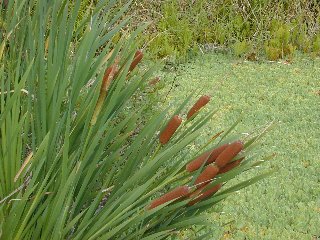|
|
|
|
A DICHOTOMOUS KEY
TO THE GRASSES, SEDGES, AND RUSHES
OF THE HAWAIIAN ISLANDS
With Links to A Key to Aquatic Plants in Hawai‘i
|
|
|
|
[NOTE: THREE CHOICES HERE]
|
. |
|
. |
|
1a
|
|
Plant generally grass-like: herbaceous, with leaves linear, very many times longer than wide, leaf veins parallel; if blades not exactly linear, veins are still parallel; OR plant a green stem without obvious leaf-like structures, or these small and sessile (leaf lacking a petiole or leaf-stem), clasping the stem. Flower heads may be conspicuous, but individual flowers are small and usually mature to some shade of brown or yellow (usually green when immature).
~ Class LILIOPSIDA (MONOCOTS, in part)
|
|
[2]
|
|
1b
|
|
Plant somewhat "grass-like" with tall, woody, hollow (jointed) stems or culms; leaves not clasping but attached to side branches by pseudo-petioles. Rarely producing flowers in Hawai‘i. Bamboos
~ Class LILIOPSIDA, Family POACEAE, Subfamily Bambusoideae
|
|
[24] 
|
|
1c
|
|
Plant not grass-like: may be herbaceous or may be woody, but leaves at most only 5 or 6 times longer than broad; leaf veins arising from a central axis or radiating from a central point. Flowers variable, but many species with conspicuously colored or otherwise showy petals. Other aquatic monocots
|
|
[107] 
|
|
~~~~ ~~~~~~~~~~~~~~~~~~~~~~~~~
|
|
|
2a
|
(1) |
Plant mostly a soft, green, vertical stem (called a culm), without leaves, or leaves present only as basal sheaths without blades, or blades inconspicuous. Flower head or heads at or near tip of stem, in some cases, with a conspicuous bract subtending (found directly below) the flower head. Certain rushes
|
|
[10] 
|
|
2b
|
|
Stem, if soft, green, and upright, then clasped by one or more long, narrow leaves or with a basal rosette of narrow leaves; OR stem otherwise (creeping, branching)
|
|
[3]
|
|
~~~~ ~~~~~~~~~~~~~~~~~~~~~~~~~
|
|
3a
|
(2)
|
Leaves in two ranks (distichous: looking down on the culm, leaves come off on two sides). Stems usually hollow except at nodes. Clasping part of leaf below blade open along a vertical seam
|
|
[4]
|
|
3b
|
|
Leaves in three ranks: looking down on the culm, leaves come off on three sides; sheathing part of leaf closed. Stem usually solid, usually trigonous (three-sided), but exceptions exist. Sedges
|
|
[15] 
|
|
~~~~ ~~~~~~~~~~~~~~~~~~~~~~~~~
|
|
4a
|
(3)
|
 Flowers arranged in a dense(and solitary) spike (1.5 - 3 cm diameter) arising above flattened, spongy, pale green leaves, lacking a midrib. Cattails
|
|
[98] 
|
|
4b
|
|
Flowers arranged in various ways, usually in several to many spikelets. Leaves linear, pale to dark green, but not fleshy or spongy, most often with a midrib that is prominent on upper or lower leaf surface. Grasses
|
|
[11] 
|